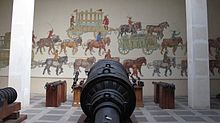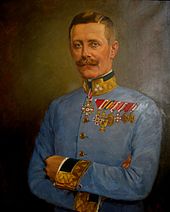Hugo of Bouvard


Hugo Reichsritter von Bouvard (born May 18, 1879 in Vienna ; † February 20, 1959 there ) was an Austrian landscape , portrait and military painter .
life and work
Bouvard came from a Savoy family of emigrants who immigrated to Austria in the second half of the 18th century . In 1901 he joined the Austro-Hungarian Army as a lieutenant . In 1908 he was given leave of absence to begin studying at the Vienna Academy under Rudolf Bacher . From 1910 Bouvard was a private student of Heinrich Knirr in Munich , after which he moved to Hans Müller in Dachau . A study trip took him to Paris in 1913 when the war broke outthe lieutenant on leave had to report to the troops immediately and was at the front in 1914. He reported as a war painter to the Austro-Hungarian War Press Headquarters , where he was accepted into the art group on December 15, 1915 with the captain's rank . During his war time, Bouvard painted and drew depictions of combat, battles and artillery from the Isonzo front . In addition, he was also artistically active in the Russian, Serbian, Romanian and Turkish theater of war. Bouvard was removed from the war press headquarters on October 9, 1916, and how he spent the rest of the war is not known.
From 1921 Hugo von Bouvard was a member of the Vienna Secession . He mainly painted portraits, especially of high officers during the war , but also landscapes and still lifes .
After World War II he was awarded (the job that "Zimeliensaal" the newly-built artillery Hall 2 Arsenal object ) of the Military History Museum to freskieren . In 1952/53 he executed the fresco with depictions of the medieval army and transport system with various baggage and sutler wagons as well as means of transport from the Maximilian era.
Works (excerpt)
- Portrait of Alexander von Brosch-Aarenau , 1934. Oil on canvas, 66 × 54 cm, Heeresgeschichtliches Museum , Vienna.
- Portrait of Count Sigmund Engl von Wagrein, imperial captain , 1948. Oil on canvas, 219 × 75 cm, Heeresgeschichtliches Museum, Vienna.
- After the storm , 1916. Oil on canvas, Heeresgeschichtliches Museum, Vienna.
literature
- Ulrich Thieme (ed.): General lexicon of visual artists from antiquity to the present . Leipzig, 1912.
Individual evidence
- ↑ Walter Reichel: "Press work is propaganda work" - Media Administration 1914-1918: The War Press Quarter (KPQ) . Communications from the Austrian State Archives (MÖStA), special volume 13, Studienverlag, Vienna 2016, ISBN 978-3-7065-5582-1 , p. 179.
- ↑ Österreichisches Heeresmuseum (Ed.): Catalog of the war picture gallery of the Austrian Army Museum , Vienna 1923, p. 9
- ↑ Ulrich Thieme (ed.), General Lexicon of Fine Artists from Antiquity to the Present. Leipzig, reprint 1953, I, 288.
- ↑ Manfried Rauchsteiner : Phoenix from the ashes. Destruction and reconstruction of the Army History Museum 1944 to 1955, volume accompanying the special exhibition of the Army History Museum June 21 to October 20, 2005 Vienna 2005, p. 99.
| personal data | |
|---|---|
| SURNAME | Bouvard, Hugo von |
| ALTERNATIVE NAMES | Bouvard, Hugo Reichsritter von (full name) |
| BRIEF DESCRIPTION | Austrian landscape painter |
| DATE OF BIRTH | May 18, 1879 |
| PLACE OF BIRTH | Vienna |
| DATE OF DEATH | February 20, 1959 |
| Place of death | Vienna |